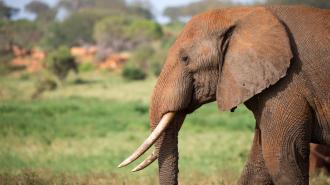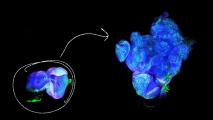Most elephant ivory smuggled out of Africa can be credited to three international crime groups, a new study finds.
Researchers using cell phone records, shipment logs, and elephant DNA have solved poaching mysteries and identified trafficking networks across the continent.
Genetic detectives: Researchers from the University of Washington’s Center for Environmental Forensic Science looked at the genetic links between DNA samples from more than 4,000 African elephant tusks seized over the last 12 years.
“The connectivity that we got of an individual transnational criminal organization to seizures was absolutely mind-blowing. I mean, some of them are connected to 30 different seizures.”
Samuel Wasser
This research builds on previous work by the same UW team. Initially, the team used DNA to identify elephant tusks from the same animal that were divided into separate shipments. That allowed them to locate regions where cartels were most active. Now, they have expanded their web of connections by linking elephant tusks from close relatives — like parent and child elephants.
“If you’re trying to match one tusk to its pair, you have a low chance of a match. But identifying close relatives is going to be a much more common event, and can link more ivory seizures to the same smuggling networks,” lead author biologist Samuel Wasser told Futurism.
Their study, published in the journal Nature Human Behaviour, suggests that poachers likely returned to the same elephant family again and again, then repeatedly used the same shipping company to smuggle the elephant tusks. Testing more than 4,000 elephant tusks from 49 large ivory seizures that were shipped out of Africa between 2002 to 2019 revealed that most of these shipments were linked together.
What this means for poachers and elephants: About 10,000 African elephants are killed each year, reports NPR. Their ivory is then loaded into shipping containers, sent to ports across Africa, and sold for use in ornaments, figurines, or jewelry.
Illegal ivory trafficking has nearly wiped out the two elephant species in Africa. With climate change and habitat loss, these giant land animals are endangered, and their population has been declining. (Although some countries, such as Kenya, have recently bucked the trend.)
The information gleaned from the DNA analysis could be used as evidence to prosecute ivory smugglers.
“The connectivity that we got of an individual transnational criminal organization to seizures was absolutely mind-blowing. I mean, some of them are connected to 30 different seizures,” Wasser told NPR.
The bigger picture: This isn’t the first time DNA evidence from a smuggled organism was used to identify a poacher. Last year, tree DNA was used to convict someone who stole valuable trees from a protected forest in the U.S.
By creating a genetic database of protected tree species, researchers are also linking genetic samples to where they originated. If a lumber sample is closely related to trees in a protected forest, it may suggest that the tree was cut illegally.
This type of genetic analysis has also been used to identify where shark fins came from and if they were collected illegally. What will come next if genetics can unlock the illegal trade of endangered or protected species like bigleaf maple trees, elephants, and sharks?
“When we make these connections genetically linking seizures to one another, that then tells law enforcement that all the physical evidence they’re collecting can be tied together and joined into a bigger whole, and it builds a much, much stronger investigation,” Dr. Wasser said.
We’d love to hear from you! If you have a comment about this article or if you have a tip for a future Freethink story, please email us at [email protected].






